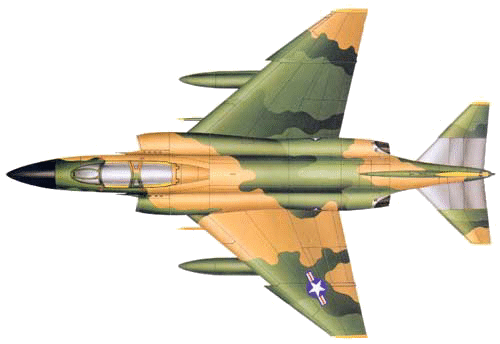|

McDonnell F-4C Phantom
The Phantom II, among its other
achievements, was the first fighter designed specifically for shipboard
use to be adopted by the USAF as well . Its successful 'ground' career
began on March 30, 1962 (after a single F-4B had proved itself far
superior to a Convair F-106A) when the USAF placed an order for an
air-superiority and tactical support version. The prototype of this, the
F-4C, took to the air on May 27, 1963, and 583 were eventually built. Then
followed 503 RF-4C photoreconnaissance planes (delivery commencing June
1964), 825 F-4Ds (first flight December 7, 1965), and about 1,500 F-4Es
(first flight June 30, 1967), of which almost one-third were exported.
Overall production ended in October 1979, by which time over 5,100 Phantom
IIs had been built in the USA and 140 under license in Japan. The F-4 flew
under the USAF insignia for practically the entire period of the Vietnam
War. From 1975 the Phantom IIs were gradually replaced by F-14s, and
although mainly consigned to reserve units, they are still used for front
line duty in many countries.
The first F-4C Phantoms of the USAF
arrived in Vietnam at the same time as those of the Marines, in April
1965, with the 45th Tactical Fighter Squadron, followed by those of the
12th TFW, in November, and of the 8th TFW, which was stationed at the Ubon
base in Thailand in December of the same year. The Phantoms were detailed
to play a defensive fighter role, escorting the F-105s weighted down with
their bomb-loads, but when the ranks of the latter began to thin out, the
Phantoms also took on attacking roles, achieving excellent results with
their precision bombing. Although many units covered themselves with glory
in eight years of war, it was the 8th TFW, among the first to reach
Vietnam, which was most highly distinguished in battle. On January 2,
1967, F-4Cs of this Wing played a key role in the biggest aerial encounter
of the war, shooting down seven MiG-21s without loss; and the 555th TFS
(which with the 432nd and 433rd formed the 8th TFW) achieved more
victories than any other USAF squadron, with a tally of 39 MiGs. In such
dogfights the radar-controlled Sparrow air-to-air missiles and
heat-sensitive Sidewinders proved invaluable, but the lack of a
traditional cannon, notably for strike missions, soon became evident. It
was for this reason that the F-4E version, sent into action toward the end
of the war, was equipped with a rotary 20mm cannon, soon proving its worth
not only in hitting the enemy on the ground but also in shooting down six
enemy jets. By the end of the war the F-4s of the USAF boasted a record of
82 victories in air duels with MiGs, the success ratio in favour of the
Phantom pilots being more than two to one.



Technical Specifications
Aircraft:
McDonnell F-4C
Year: 1963
Type: fighter-bomber
Manufacturer: McDonnell Aircraft Corp.
Engine: 2 x General Electric J79GE-15
Power: 17,000 lb (7,711 kg)
Wingspan: 38ft 5in (11.70m)
Length: 58ft 3 3/4in (17.78m)
Height: 16ft 3in (4.95m)
Wing area: 530sq ft (49.23mē)
Max take-off weight: 51,441 lb (23,334 kg)
Empty weight: 28,496 lb (12,926 kg)
Max speed: 1,433mph at 40,000ft (2,306km/h at 12,192m)
Service ceiling: 56,100ft (17,099m)
Range: 538mi (866km)
Crew: 2
Load-armament: 4 missiles; 16,000 lb (7,275 kg)
|
